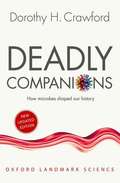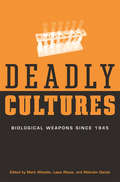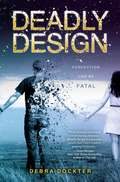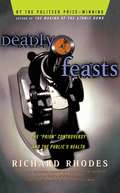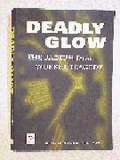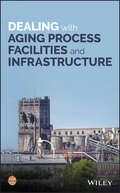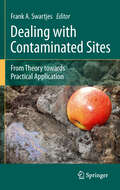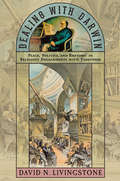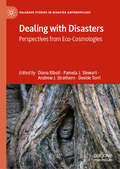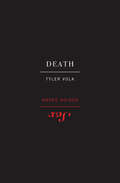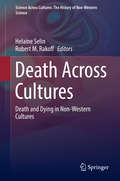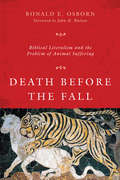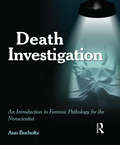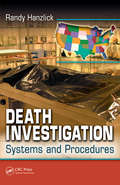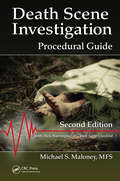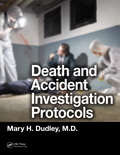- Table View
- List View
Deadly Choices: How the Anti-vaccine Movement Threatens Us All
by Paul A. OffitThere's a silent, dangerous war going on out there. On one side are parents, bombarded with stories about the dangers of vaccines, now wary of immunizing their sons and daughters. On the other side are doctors, scared to send kids out of their offices vulnerable to illnesses like whooping cough and measles--the diseases of their grandparents.How did anyone come to view vaccines with horror? The answer is rooted in one of the most powerful citizen activist movements in our nation's history. In Deadly Choices, infectious disease expert Paul Offit relates the shocking story of anti-vaccine America--its origins, leaders, influences, and impact. Offering strategies to keep us from returning to an era when children routinely died from infections, Deadly Choices is a vigorous and definitive rebuttal of the powerful anti-vaccine movement.
Deadly Companions: How Microbes Shaped Our History
by Dorothy H. CrawfordBeginning with a dramatic account of the SARS pandemic at the start of the 21st century, she takes us back in time to follow the interlinked history of microbes and man, taking an up-to-date look at ancient plagues and epidemics, and identifying key changes in the way humans have lived - such as our move from hunter-gatherer to farmer to city-dweller - which made us vulnerable to microbe attack.
Deadly Cultures: Biological Weapons since 1945
by Lajos RózsaThe threat of biological weapons has never attracted as much public attention as in the past five years. Current concerns largely relate to the threat of weapons acquisition and use by rogue states or by terrorists. But the threat has deeper roots—it has been evident for fifty years that biological agents could be used to cause mass casualties and large-scale economic damage. Yet there has been little historical analysis of such weapons over the past half-century. Deadly Cultures sets out to fill this gap by analyzing the historical developments since 1945 and addressing three central issues: Why have states continued or begun programs for acquiring biological weapons? Why have states terminated biological weapons programs? How have states demonstrated that they have truly terminated their biological weapons programs? We now live in a world in which the basic knowledge needed to develop biological weapons is more widely available than ever before. Deadly Cultures provides the lessons from history that we urgently need in order to strengthen the long-standing prohibition of biological weapons.
Deadly Design
by Debra DockterThe emotional power of If I Stay meets the survival story of Maze Runner Genetically engineered identical twins Kyle and Connor McAdams were born two years apart. Their parents figured it was safer that way, to increase their odds of survival. Connor was born first, paving an impossibly perfect path for Kyle to follow. He was the best at everything--valedictorian, star quarterback etc. Kyle never thought he'd be able to live up, so he didn't even try. But when Connor, 18, suddenly drops dead of a heart attack, and Kyle learns of other genetically modified kids who've also died on their eighteenth birthdays, he's suddenly motivated--to save his own life. Like Connor and all the rest, Kyle was conceived at the Genesis Innovations Laboratory, where the mysterious Dr. Mueller conducted experiments on them. The clock's ticking as Kyle searches for answers: who was Dr. Mueller really, and what did he do to cause their hearts to stop at eighteen? He must unravel the clues quickly, before, he too, becomes another perfect, blue-eyed corpse.
Deadly Feasts: Tracking the Secrets of a Terrifying New Plague
by Richard RhodesRichard Rhodes follows virus hunters on three continents as they track the emergence of a deadly new brain disease that first kills cannibals in New Guinea, then cattle and young people in Britain and France -- and that has already been traced to food animals in the United States. In a new Afterword for the paperback, Rhodes reports the latest U. S. and worldwide developments of a burgeoning global threat.
Deadly Glow: The Radium Dial Worker Tragedy
by Ross MullnerDeadly Glow: The Radium Dial Worker Tragedy
Deadly Outbreaks: How Medical Detectives Save Lives Threatened by Killer Pandemics, Exotic Viruses, and Drug-Resistant Parasites
by Alexandra LevittDespite advances in health care, infectious microbes continue to be a formidable adversary to scientists and doctors. Vaccines and antibiotics, the mainstays of modern medicine, have not been able to conquer infectious microbes because of their amazing ability to adapt, evolve, and spread to new places. Terrorism aside, one of the greatest dangers from infectious disease we face today is from a massive outbreak of drug-resistant microbes.Deadly Outbreaks recounts the scientific adventures of a special group of intrepid individuals who investigate these outbreaks around the world and figure out how to stop them. Part homicide detective, part physician, these medical investigators must view the problem from every angle, exhausting every possible source of contamination. Any data gathered in the field must be stripped of human sorrows and carefully analyzed into hard statistics.Author Dr. Alexandra Levitt is an expert on emerging diseases and other public health threats. Here she shares insider accounts she's collected that go behind the alarming headlines we've seen in the media: mysterious food poisonings, unexplained deaths at a children's hospital, a strange neurologic disease afflicting slaughterhouse workers, flocks of birds dropping dead out of the sky, and drug-resistant malaria running rampant in a refugee camp. Meet the resourceful investigators--doctors, veterinarians, and research scientists--and discover the truth behind these cases and more.
Deadly Predators (National Geographic Kids Readers)
by Melissa StewartCome face-to-face with sharks, wolves, tigers, and many more predators in this gripping new addition to the National Geographic Kids Reader series. Amazing animal photos will wow kids as they discover how predators hunt, raise their young, and contribute to the food chain. This Level 2 reader is written in easy-to-grasp text and will help kids understand who rules in the wild!
Dealing with Aging Process Facilities and Infrastructure
by CcpsExamines the concept of aging process facilities and infrastructure in high hazard industries and highlights options for dealing with the problem while addressing safety issues This book explores the many ways in which process facilities, equipment, and infrastructure might deteriorate upon continuous exposure to operating and climatic conditions. It covers the functional and physical failure modes for various categories of equipment and discusses the many warning signs of deterioration. Dealing with Aging Process Facilities and Infrastructure also explains how to deal with equipment that may not be safe to operate. The book describes a risk-based strategy in which plant leaders and supervisors can make more informed decisions on aging situations and then communicate them to upper management effectively. Additionally, it discusses the dismantling and safe removal of facilities that are approaching their intended lifecycle or have passed it altogether. Filled with numerous case studies featuring photographs to illustrate the positive and negative experiences of others who have dealt with aging facilities, Dealing with Aging Process Facilities and Infrastructure covers the causes of equipment failures due to aging and their consequences; plant management commitment and responsibility; inspection and maintenance practices for managing life cycle; specific aging asset integrity management practices; and more. Describes symptoms and causal mechanisms of aging in various categories of process equipment Presents key considerations for making informed risk-based decisions regarding the repair or replacement of aging process facilities and infrastructure Discusses practices for managing process facility and infrastructure life cycle Includes examples and case histories of failures related to aging Dealing with Aging Process Facilities and Infrastructure is an important book for industrial practitioners who are often faced with the challenge of managing process facilities and infrastructure as they approach the end of their useful lifecycle.
Dealing with Contaminated Sites
by Frank A. SwartjesThis standard work on contaminated site management covers the whole chain of steps involved in dealing with contaminated sites, from site investigation to remediation. An important focus throughout the book is on Risk Assessment. In addition, the book includes chapters on characterisation of natural and urban soils, bioavailability, natural attenuation, policy and stakeholder viewpoints and Brownfields. Typically, the book includes in-depth theories on soil contamination, along with offering possibilities for practical applications. More than sixty of the world's top experts from Europe, the USA, Australia and Canada have contributed to this book. The twenty-five chapters in this book offer relevant information for experienced scientists, students, consultants and regulators, as well as for 'new players' in contaminated site management
Dealing with Darwin: Place, Politics, and Rhetoric in Religious Engagements with Evolution (Medicine, Science, and Religion in Historical Context)
by David N. LivingstoneHow was Darwin’s work discussed and debated among the same religious denomination in different locations?Using place, politics, and rhetoric as analytical tools, historical geographer David N. Livingstone investigates how religious communities sharing a Scots Presbyterian heritage engaged with Darwin and Darwinism at the turn of the twentieth century. His findings, presented as the prestigious Gifford Lectures, transform our understandings of the relationship between science and religion.The particulars of place—whether in Edinburgh, Belfast, Toronto, Princeton, or Columbia, South Carolina—shaped the response to Darwin’s theories. Were they tolerated, repudiated, or welcomed? Livingstone shows how Darwin was read in different ways, with meaning distilled from Darwin's texts depending on readers' own histories—their literary genealogies and cultural preoccupations. That the theory of evolution fared differently in different places, Livingstone writes, is "exactly what Darwin might have predicted. As the theory diffused, it diverged." Dealing with Darwin shows the profound extent to which theological debates about evolution were rooted in such matters as anxieties over control of education, the politics of race relations, the nature of local scientific traditions, and challenges to traditional cultural identity. In some settings, conciliation with the new theory, even endorsement, was possible—demonstrating that attending to the specific nature of individual communities subverts an inclination to assume a single relationship between science and religion in general, evolution and Christianity in particular. Livingstone concludes with contemporary examples to remind us that what scientists can say and what others can hear in different venues differ today just as much as they did in the past.
Dealing with Disasters: Perspectives from Eco-Cosmologies (Palgrave Studies in Disaster Anthropology)
by Pamela J. Stewart Andrew J. Strathern Davide Torri Diana RiboliProviding a fresh look at some of the pressing issues of our world today, this collection focuses on experiential and ritualized coping practices in response to a multitude of environmental challenges—cyclones, volcanic eruptions, tsunamis, earthquakes, warfare and displacements of peoples and environmental resource exploitation. Eco-cosmological practices conducted by skilled healing practitioners utilize knowledge embedded in the cosmological grounding of place and experiences of place and the landscapes in which such experience is encapsulated. A range of geographic case studies are presented in this volume, exploring Asia, Europe, the Pacific, and South America. With special reference throughout to ritual as a mode of seeking the stabilization, renewal, and continuity of life processes, this volume will be of particular interest to readers working in shamanic and healing practices, environmental concerns surrounding sustainability and conservation, ethnomedical systems, and religious and ritual studies.
Dear Moon
by Stephen WunderliIn this poignant story of grief and healing, Max learns that time will keep ticking and loss is inevitable, but memories last forever.
Dear NHS: 100 Stories to Say Thank You, Edited by Adam Kay
by VariousTHE NUMBER ONE SUNDAY TIMES BESTSELLERCurated and edited by Adam Kay (author of multi-million bestseller This is Going to Hurt), Dear NHS features 100 household names telling their personal stories of the health service. Contributors include: Paul McCartney, Emilia Clarke, Peter Kay, Stephen Fry, Sir Trevor McDonald, Graham Norton, Sir Michael Palin, Naomie Harris, Sir David Jason, Dame Emma Thompson, Joanna Lumley, Miranda Hart, Jamie Oliver, Ed Sheeran, David Tennant, Dame Julie Walters, Emma Watson, Malala Yousafzai and many, many more. All profits from this book will go to NHS Charities Together to fund vital research and projects, and The Lullaby Trust which supports parents bereaved of babies and young children.Other writers include Jack Whitehall, Chris Evans, Lorraine Kelly, Lee Mack, Jonathan Ross, Konnie Huq, Frank Skinner, KT Tunstall and Sandi Toksvig. The NHS is our single greatest achievement as a country. No matter who you are, no matter what your health needs are, and no matter how much money you have, the NHS is there for you. In Dear NHS, 100 inspirational people come together to share their stories of how the national health service has been there for them, and changed their lives in the process. By turns deeply moving, hilarious, hopeful and impassioned, these stories together become a love letter to the NHS and the 1.4 million people who go above and beyond the call of duty every single day - selflessly, generously, putting others before themselves, never more so than now. They are all heroes, and this book is our way of saying thank you.Contributors include: Dolly Alderton, Monica Ali, Kate Atkinson, Pam Ayres, David Baddiel, Johanna Basford, Mary Beard, William Boyd, Frankie Boyle, Jo Brand, Kevin Bridges, Alex Brooker, Charlie Brooker, Rob Brydon, Bill Bryson, Kathy Burke, Peter Capaldi, Jimmy Carr, Candice Carty-Williams, Lauren Child, Lee Child, Bridget Christie, Emilia Clarke, Rev Richard Coles, Daisy May Cooper, Jilly Cooper, Fearne Cotton, Juno Dawson, Kit de Waal, Victoria Derbyshire, Reni Eddo-Lodge, Chris Evans, Anne Fine, Martin Freeman, Dawn French, Stephen Fry, Mark Gatiss, Ricky Gervais, Professor Green, Baroness Tanni Grey-Thompson, Mark Haddon, Matt Haig, The Hairy Bikers, Naomie Harris, Miranda Hart, Victoria Hislop, Nick Hornby, Sali Hughes, Konnie Huq, Marina Hyde, E L James, Greg James, Sir David Jason, Katarina Johnson-Thompson, Jackie Kay, Peter Kay, Lorraine Kelly, Marian Keyes, Shappi Khorsandi, Nish Kumar, Stewart Lee, Joanna Lumley, Lee Mack, Emily Maitlis, Andrew Marr, Catherine Mayer, Alexander McCall Smith, Paul McCartney, Sir Trevor McDonald, Caitlin Moran, Kate Mosse, Jojo Moyes, David Nicholls, John Niven, Graham Norton, Chris O'Dowd, Dermot O'Leary, Jamie Oliver, Sir Michael Palin, Maxine Peake, Sue Perkins, Katie Piper, Ian Rankin, Jonathan Ross, Ed Sheeran, Paul Sinha, Frank Skinner, Matthew Syed, Kae Tempest, David Tennant, Louis Theroux, Dame Emma Thompson, Sandi Toksvig, Stanley Tucci, KT Tunstall, Johnny Vegas, Danny Wallace, Dame Julie Walters, Phil Wang, Emma Watson, Mark Watson, Robert Webb, Irvine Welsh, Jack Whitehall, Josh Widdicombe, Dame Jacqueline Wilson, Greg Wise, Malala Yousafzai, Benjamin Zephaniah.A minimum of £3.09 from the sale of each book will be paid to NHS Charities Together and £0.16 will be paid to The Lullaby Trust.
Dear NHS: 100 Stories to Say Thank You, Edited by Adam Kay
by VariousTHE NUMBER ONE SUNDAY TIMES BESTSELLERCurated and edited by Adam Kay (author of multi-million bestseller This is Going to Hurt), Dear NHS features 100 household names telling their personal stories of the health service. Contributors include: Paul McCartney, Emilia Clarke, Peter Kay, Stephen Fry, Sir Trevor McDonald, Graham Norton, Sir Michael Palin, Naomie Harris, Sir David Jason, Dame Emma Thompson, Joanna Lumley, Miranda Hart, Jamie Oliver, Ed Sheeran, David Tennant, Dame Julie Walters, Emma Watson, Malala Yousafzai and many, many more. All profits from this book will go to NHS Charities Together to fund vital research and projects, and The Lullaby Trust which supports parents bereaved of babies and young children.Other writers include Jack Whitehall, Chris Evans, Lorraine Kelly, Lee Mack, Jonathan Ross, Konnie Huq, Frank Skinner, KT Tunstall and Sandi Toksvig. The NHS is our single greatest achievement as a country. No matter who you are, no matter what your health needs are, and no matter how much money you have, the NHS is there for you. In Dear NHS, 100 inspirational people come together to share their stories of how the national health service has been there for them, and changed their lives in the process. By turns deeply moving, hilarious, hopeful and impassioned, these stories together become a love letter to the NHS and the 1.4 million people who go above and beyond the call of duty every single day - selflessly, generously, putting others before themselves, never more so than now. They are all heroes, and this book is our way of saying thank you.Contributors include: Dolly Alderton, Monica Ali, Kate Atkinson, Pam Ayres, David Baddiel, Johanna Basford, Mary Beard, William Boyd, Frankie Boyle, Jo Brand, Kevin Bridges, Alex Brooker, Charlie Brooker, Rob Brydon, Bill Bryson, Kathy Burke, Peter Capaldi, Jimmy Carr, Candice Carty-Williams, Lauren Child, Lee Child, Bridget Christie, Emilia Clarke, Rev Richard Coles, Daisy May Cooper, Jilly Cooper, Fearne Cotton, Juno Dawson, Kit de Waal, Victoria Derbyshire, Reni Eddo-Lodge, Chris Evans, Anne Fine, Martin Freeman, Dawn French, Stephen Fry, Mark Gatiss, Ricky Gervais, Professor Green, Baroness Tanni Grey-Thompson, Mark Haddon, Matt Haig, The Hairy Bikers, Naomie Harris, Miranda Hart, Victoria Hislop, Nick Hornby, Sali Hughes, Konnie Huq, Marina Hyde, E L James, Greg James, Sir David Jason, Katarina Johnson-Thompson, Jackie Kay, Peter Kay, Lorraine Kelly, Marian Keyes, Shappi Khorsandi, Nish Kumar, Stewart Lee, Joanna Lumley, Lee Mack, Emily Maitlis, Andrew Marr, Catherine Mayer, Alexander McCall Smith, Paul McCartney, Sir Trevor McDonald, Caitlin Moran, Kate Mosse, Jojo Moyes, David Nicholls, John Niven, Graham Norton, Chris O'Dowd, Dermot O'Leary, Jamie Oliver, Sir Michael Palin, Maxine Peake, Sue Perkins, Katie Piper, Ian Rankin, Jonathan Ross, Ed Sheeran, Paul Sinha, Frank Skinner, Matthew Syed, Kae Tempest, David Tennant, Louis Theroux, Dame Emma Thompson, Sandi Toksvig, Stanley Tucci, KT Tunstall, Johnny Vegas, Danny Wallace, Dame Julie Walters, Phil Wang, Emma Watson, Mark Watson, Robert Webb, Irvine Welsh, Jack Whitehall, Josh Widdicombe, Dame Jacqueline Wilson, Greg Wise, Malala Yousafzai, Benjamin Zephaniah.A minimum of £3.09 from the sale of each book will be paid to NHS Charities Together and £0.16 will be paid to The Lullaby Trust.
Death & Sex
by Dorion Sagan Tyler VolkWhat is shared by spawning Pacific salmon, towering trees, and suicidal bacteria? In his lucid and concise exploration of how and why things die, Tyler Volk explains the intriguing ways creatures-including ourselves-use death to actually enhance life. The exquisite schemes and styles of death that have emerged from evolution have been essential to the great story from life's beginnings in tiny bacteria to ancient human rituals surrounding death and continuing to the existential concerns of human culture and consciousness today. Volk weaves together autobiography, biology, Earth history, and results of fascinating studies that show how thoughts of our own mortality affect our everyday lives, to prove how an understanding of what some have called the ultimate taboo can enrich the celebration of life. In Sex, Dorion Sagan takes a delightful, irreverent, and informative romp through the science, philosophy, and literature of humanity's most obsessive subject. Linking evolutionary biology to salacious readings of the lives and thoughts of such notables as the Marquis de Sade and Simone de Beauvoir, and discussing works as varied as The Story of O and Silence of the Lambs, Sex touches on a potpourri of interrelated topics ranging from animal genitalia to sperm competition, the difference between nakedness and nudity, jealousy's status as an aphrodisiac and the origins of language, Casanova and music, ovulation and clothes, mother-in-law jokes and alpha females, love and loneliness. Two books in one cover, Death & Sex unravel and answer some of life's most fundamental questions.
Death Across Cultures: Death and Dying in Non-Western Cultures (Science Across Cultures: The History of Non-Western Science #9)
by Helaine Selin Robert M. RakoffDeath Across Cultures: Death and Dying in Non-Western Cultures, explores death practices and beliefs, before and after death, around the non-Western world. It includes chapters on countries in Africa, Asia, South America, as well as indigenous people in Australia and North America. These chapters address changes in death rituals and beliefs, medicalization and the industry of death, and the different ways cultures mediate the impacts of modernity. Comparative studies with the west and among countries are included. This book brings together global research conducted by anthropologists, social scientists and scholars who work closely with individuals from the cultures they are writing about.
Death Before the Fall: Biblical Literalism and the Problem of Animal Suffering
by Ronald E. Osborn2014 ECPA Top Shelf Book Cover Award
Death Investigation: An Introduction to Forensic Pathology for the Nonscientist
by Ann BucholtzDeath Investigation: An Introduction to Forensic Pathology for the Nonscientist provides students and law enforcement professionals with an accurate, clear overview of forensic pathology. It presents death investigation at the scene and autopsy, providing readers with a broad understanding of forensic pathology and giving them a clear picture of what happens after the examination of the scene. Readers learn what first responders should (and should not) do at the scene, and get a forensic pathologist's perspective on the importance of preserving evidence. Death Investigation methodically explains what happens during autopsy to determine cause and manner of death -- including particulars of blunt force trauma, sharp force injuries, asphyxia, and gunshot wounds -- and how findings are presented in court. Written for a criminal justice audience by a practicing forensic pathologist and educator, Death Investigation makes challenging forensics concepts accessible to nonscientists.
Death Investigation: Systems and Procedures
by Randy Hanzlick M.D.Death Investigation: Systems and Procedures is the first book dedicated to the topic of death investigation from a legal standpoint as well as the administrative and operational procedures that pertain to the medical examiner and the coroner system in the United States. Unique in its perspective, this book is the only one not concerned with instruc
Death Receptors and Cognate Ligands in Cancer
by Holger KalthoffDeath receptors play a central role in directing apoptosis in mammalian cells. This process of active cell death is important for a number of biological processes, e.g. for the regulation of the immune system. Death receptors are cell surface receptors that transmit apoptotic signals initiated by corresponding death ligands. Many complex signaling pathways are activated and apoptosis is the final result of a complex biochemical cascade of events. Besides their role in the induction of cell death, evidence now exists that death receptors are able to activate several non-apoptotic signaling pathways which, depending on cellular context, may lead to apoptosis resistance, secretion of pro-inflammatory proteins, proliferation and invasive growth of cancer cells. This book looks at the molecular basis of death receptor signaling and the role of death receptors in cancer development.
Death Scene Investigation: Procedural Guide, Second Edition
by Michael S. MaloneyThose tasked with investigating death scenes come from a variety of backgrounds and varying levels of experience. Whether a homicide detective, crime scene investigator, medico-legal death investigator, coroner or medical examiner, Death Scene Investigation: Procedural Guide, Second Edition provides the investigator best-practice techniques and procedures for almost any death scene imaginable, including for deaths occurring even under the most unusual of circumstances. This Second Edition is fully updated to include new coverage on shallow graves, human remains at crime scenes, poisonings, expanded coverage of projectile weapons, videography, touch DNA, death notifications, and a newly added chapter dedicated to sexual deaths. In addition, the book serves as an on-scene ready reference which includes instructions on procedure including the initial notification of a death, processing the scene and body, the investigator's role at autopsy, and analyzing the scene indicators to place evidence into context. Topics discussed include: Initial response and scene evaluation Death scene management including documentation, sketching, photography, videography, observations, and search procedures A special death investigation matrix that walks the investigator though a decision tree to help in ambiguous deaths Contains discussion of all manners of death, including accident, suicide, natural and homicide Coverage of recovery of human remains from open field, aquatic, and buried sites including estimating the time of death. Wound dynamics and mechanisms of injury that covers asphyxiation, sharp and blunt force trauma, chopping injuries; handgun, rifle, and shotgun wounds, electrical injuries, and more The bulleted format and spiral binding allows for easy use and reference in the field with sections that are self-contained and cross-referenced for quick searches. With its thorough and detailed approach, Death Scene Investigation, Second Edition will be a must-have addition to any crime scene and death investigator’s tool kit.
Death Scenes
by Sean Tejaratchi Dunn KatherineThe strange and gruesome crime-scene snapshot collection of LAPD detective Jack Huddleston spans Southern California in its noir heyday. Death Scenes is the noted forerunner of several copycat titles.
Death Valley Rocks & Minerals (Destinations In Science)
by David C. BrummettDeath Valley impresses more than a million visitors each year, and anyone with a feeling for geology surely considers it a choice destination. It is a vast showcase of rocks and landforms, testifying to geologic events over billions of years. And most compelling for specialists, Death Valley displays the evidence and effects of extreme crustal extension, revealing the rarely seen doings of the deep crust in a setting where the faults and rocks are exposed in extraordinary detail.
Death and Accident Investigation Protocols
by Mary H. DudleyThrough an examination and assessment of the body at a death scene, the medicolegal death investigator (MLDI) must be able to recognize circumstances that point to what manner of death occurred—be it natural causes, homicide, suicide, accident, or undetermined. A handy reference for use in the field and in the lab, Death and Accident Investigation Protocols provides 34 checklists and forms to help investigators make these determinations.Categories of death covered in this guide include: Aircraft and motor vehicle accident Alcohol- and drug-related Blunt- and sharp-force injury Drowning Electrocution, exposure, and fire Gunshot Hanging Hospital- and nursing home-related Infectious disease Natural causes Occupational exposure Poison and toxic substances Sexual assault Suicide Formatted as a convenient 8 ½ x 11 spiral-bound book, this manual helps investigators know what to look for, what questions to ask, and how to categorize the scene and the physical injuries. The forms in the book can either be downloaded, which allows for easy form modification. The text includes descriptive illustrations and diagrams associated with various categories of death. An essential tool for the busy investigator, the book facilitates the organization of information for a myriad of death scenarios.

